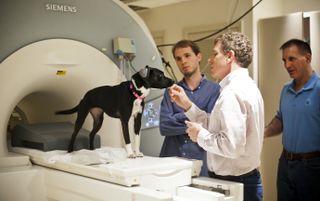Brain Scans Show Dogs Do Pay Attention to Owners

Do dogs have empathy? Do they know when you are happy or sad? And do they really understand you? These are questions researchers hope to answer now that they’ve done what they claim to be the first imaging of an alert dog’s brain.
Already, the results confirm that dogs — at least some of them — pay very close attention to their owners. (We’re interested in seeing the same test done on cats!)
The study involved harmless functional Magnetic Resonance Imaging (fMRI).
In one experiment, the dogs were trained to respond to hand signals. One signal meant the dog would receive a hot dog treat, and another signal meant it would not receive one. The caudate region of the brain, associated with rewards in humans, showed activation in both dogs when they saw the signal for the treat, but not for the no-treat signal. “These results indicate that dogs pay very close attention to human signals,” said Gregory Berns, director of the Emory University Center for Neuropolicy and lead researcher of the dog project. “And these signals may have a direct line to the dog’s reward system.”
The study — it’s biggest accomplishment being to actually scan dog’s brains while they’re active — is detailed in the journal PLoS ONE.
“It was amazing to see the first brain images of a fully awake, unrestrained dog,” Berns said. “As far as we know, no one has been able to do this previously. We hope this opens up a whole new door for understanding canine cognition and inter-species communication. We want to understand the dog-human relationship, from the dog’s perspective.”
Sign up for the Live Science daily newsletter now
Get the world’s most fascinating discoveries delivered straight to your inbox.
Most Popular


